Rebel Painters Part 5: Heads Roll! Artemisia Gentileschi at the National Gallery

‘As long as I live I will have control over my being’
Artemisia Gentileschi
Head Count
Heads bob, set off starkly against blue gallery walls. White heads, white skin, grey hair, white hair, ears pinned forward by tight elastic, eyes squinting, peering at paint made into young luminescent flesh and too-small gallery labels as we eagerly join together to study the work of Artemisia Gentileschi 1593- c 1656. Occasionally a black or Asian head breaks the rhythm of the circuit as a guard moves amongst the crowd, easing aching legs. It’s a sad indictment of our time that in 2020 there is an obvious racial divide between these passionate energetic white elders- the lifeblood of the National Gallery- and the museum staff who are making everyone feel so welcome.
It’s a very good thing that the senior crowd has made such an effort to turn up here today. Mid pandemic the tourists are absent and the NG is missing its school parties and the diversity of an audience that constitutes real London, an audience that will ensure its future and its relevance. You wonder what will happen when this eager well-heeled elderly audience doesn’t come, can’t come, won’t come.
Head Dress
Fear of the pandemic will have already made the decision to stay away from beloved cultural spaces for some elders, and rightly so. There is some speculation that the great plague of Naples in 1656 may have ended the life of the painter we are looking at.
So here we are then, heads dressed in masks, grateful to be healthy, glad to be back at the NG and to be pulled by Artemisia G. into a Baroque era Italy, four hundred years ago. Bring me the head of Holhofernes.
Head Start
I step up to the threshold just noticing the elderly couple forming a very small queue in time. I hold back as a tall elderly man turns to me and gruffly mumbles ‘Queue!’.
I resist the temptation to say ‘Innit!’. Maskmuffle reduces conversation to bare essentials.
Head Trauma
I’ve been waiting a long time for an exhibition of this artist’s work and I’ve waited a long time to write this blog post. Now I’m looking at her face as depicted in a series of self-portraits and I’m struck by the glint of defiance in her eye.
Artemisia reminds me of the brilliant actress Samantha Morton and if I were ever casting for a film about her life, which I’m not likely to be, I would go to her first. Morton is always achingly honest in her work, a core of steely strength runs through each character that she protrays. Maybe these aspects of her acting career are the result of trauma she has mentioned suffering as a child and the difficult upbringing she endured in the care system. Similarly, it is trauma blights the life of young Artemisia and creates the narrative prism through which we view her career as an artist.
The first fact that you will be aware of when you are introduced to her work is that she was raped at the age of 17.The second fact is that she took her attacker to court and had him prosecuted. Fewer than one in 65 rape cases end in prosecution and that’s in 21st Century Britain, so you can imagine what was at stake for Artemisia when she testified and what further shame it might bring to her reputation.
Head Held High
There was a Golden Globe winning film made about Artemisia in 1997. A ‘bodice ripper with a brain’ according to NYT film critic Stephen Holden. I’ve not seen it yet but I hope that the actress who portrayed her ripped her own bodices because despite the lowly status of women in the Baroque period Artemisia Gentileschi was more than a match for any man and she is without doubt one of the finest painters I’ve ever seen.
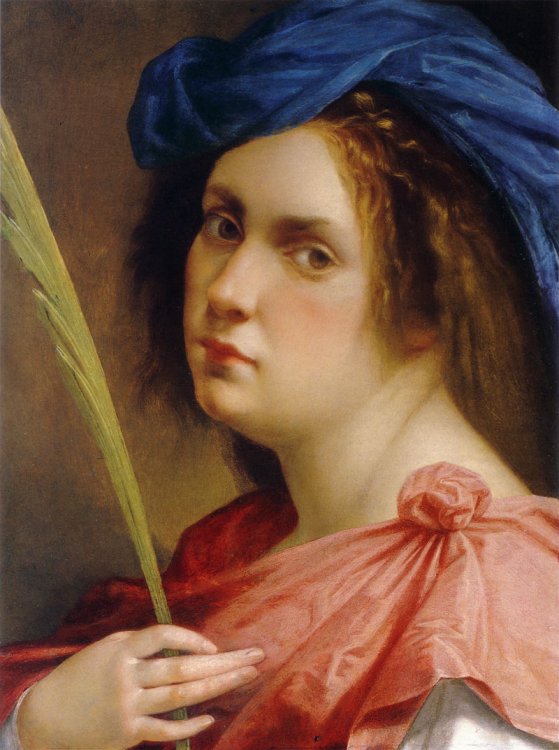
Artemisia Gentileschi Self Portrait 1615
Two Heads Are Not Better Than One
And there’s the rub- I’ve already fallen into the trap of writing about Artemisia as defined by her gender. One quick head rotation of these rooms at the National Gallery and you realise you are in the presence of an artist who defies the parameters by which we construct our fragile identities. And yet, only a woman could have such insight into the darkness of the male world. Standing beneath the naked Susannah in Susannah and the Elders1610 as she is spied on none too subtly by two fully cloaked conjoined men- ‘elders’- whispering inaudible obscenities as they plan to attack her, we know we are complicit. We are making a safe space for the sexual thrills of this two-headed, two-faced, multi-groping monstrosity of manhood. A red cloak of voyeuristic acceptability is wrapping the scene.
No photos says the blurb on the text. Let’s keep this one between ourselves, under wraps, you never saw anything, ok? Let’s teach her a lesson. Silence her once and for all. She was gagging for it anyway. Gagging.
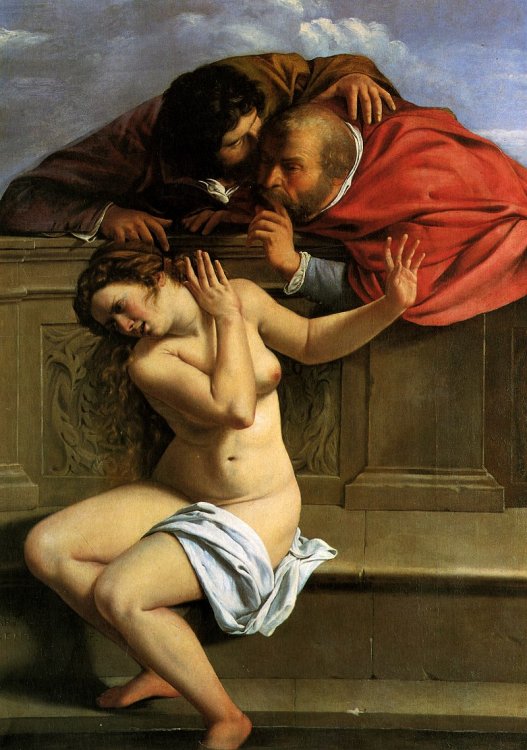
Susannah and the Elders 1610
In the Biblical story of Susannah and the Elders the men attempt a sexual attack on Susannah. She fends them off, refusing their attempts at blackmail, Daniel has them questioned and their separate stories fall apart under cross examination and Susannah triumphs.
Then you notice Susannah’s foot, entering the water, breaking the surface. Reverse sexual symbolism aside, this is an artist who is saying to her elders, her peers, her contemporaries ‘I’m only just beginning. Watch and learn you suckers. You’ll never stop me speaking my truth’.
And then you do the math and you calculate that this artist was 16 years old when she painted this painting. And then you think back and ask yourself, what was I doing at 16? I wasn’t doing much math for sure. And then you realise that just one year after Artemisia painted this she was raped.
Artemisia had to defend herself against her rapist and then against a gathering of men in a court of law, some of whom were probably members of the dirty cloak brigade. It’s no wonder Artemisia has written Daniel out of the scene. Who needs a man to defend you, to define you, to speak on your behalf? Who needs anyone when you can paint like this?
Headstrong
The painting Susannah and the Elders reveals that aged 16 Artemisia was all too aware that her refusal to conform to expected notions of female behaviour carried the risk of violent masculine retribution. She was a threat to manhood, she needed to be tamed and yet she was undeterred. She continued mixing pigments, adding colour to canvas, executing ideas, sharpening her knife.
Heads Or Tails
In opposition to this scene of masculine power play there is a small painting entitled Danae from 1612. This painting is of such beauty that I find it hard to move on to the next.
Painted on copper, in rich lush colours, Danae 1621 rests on the bed writhing in ecstasy as Zeus visits her in the form of a shower of gold. A maidservant opens her shawl and to catch the coins that catch the light as they rain down.
It’s Raining Heads
The movement of the coins through the air in this painting is so well executed that you can hear them falling to the ground in your mind, dropping onto cloth, gently jangling as you experience the cool weight of them lying on Danae’s skin, slipping into her lap.This is Danae’s/ Artemisia’s moment. She is in control.
It’s possible to imagine that each of these falling coins would carry the image of a male head on its surface, a head of state, an Emperor even, as was often the custom. Halelulliah! It’s raining heads! Right into Danae’s/ Artemisia’s lap.
“You will find the spirit of Caesar in this soul of a woman”
Artemisia Gentileschi
One version of this painting sold at Sotheby’s New York in 2016 for an equally cool $30,500.000, purchased by the Getty Museum.
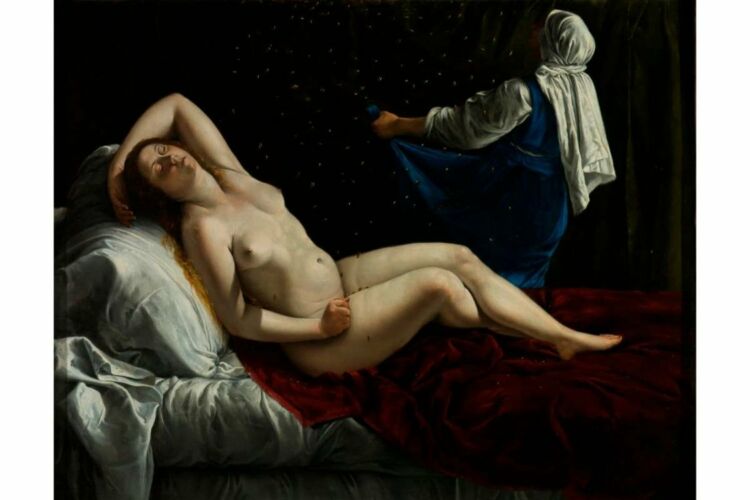
Danae 1612
Head In A Basket
In this exhibition you will find two paintings side by side, Gentileschi father and daughter depicting the same scene, Judith and her Maidservant. There is no doubt that her father Orazio’s painting is extremely accomplished. The composition is more centered than Artemisia’s with the severed head of Holhofernes placed just off centre, leading our eye led to this man’s head- the full horror staring us in the face. This is a painting about castration that much is obvious but Artemisia’s painting of 1613 is zoomed in somewhat, the focus is on the women, the horror is amplified by Judith’s blank exhausted expression, there was no choice in this matter, they took control, got the job done and now they just have to deal with this object.
The head and the basket are beautifully observed, if I can use those words. A basket is a powerful symbol of classical femininity, every homemaker needs one, right girls? Well guess what, Judith/ Artemisia, just found a new use for it. A bloody head in lies in hers, tilted towards us, ready to roll. Holhofernes looks restful, finally relieved of his sad life and stuffed into the circular reed-woven womb.
A not-very-subtle message is being spelled out for us here; women give life, they deal with its bloody beginnings and they care for much of the mess of life along the way; so women can take it away if they want. In a basket. Deal with it, and Don’t Mess! Don’t be losin’ your head.
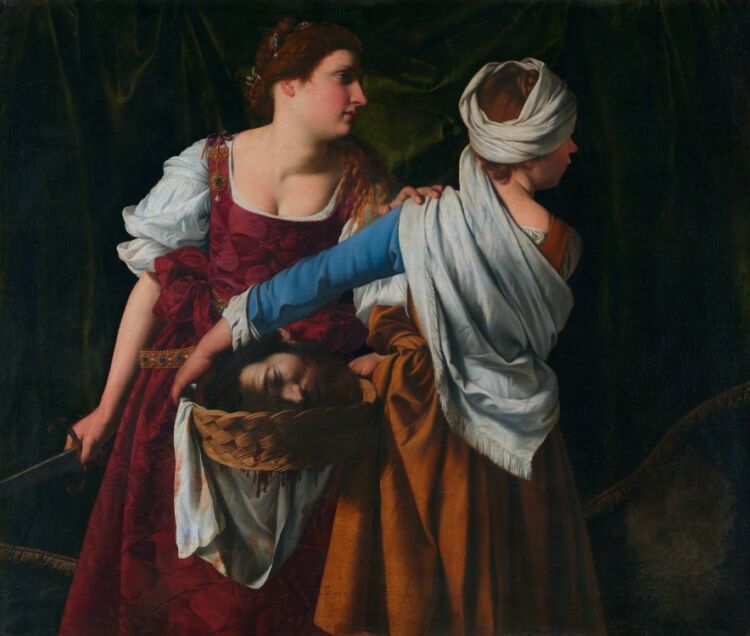
Orazio Gentileschi Judith and her Maidservant 1608
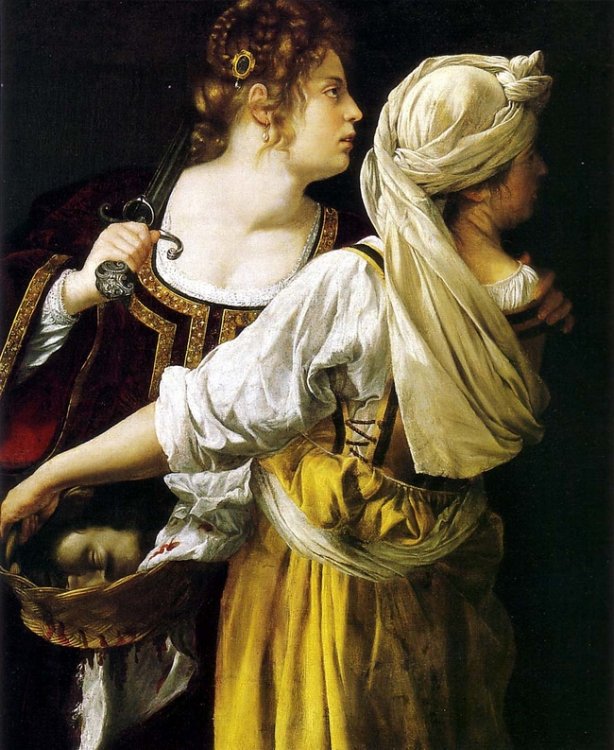
Artemisia Gentileschi Judith and her Maidservant 1613
Head Rush
Nearby are versions of Judith Slaying Holhofernes. More heads are being held down, blood is spurting so realistically, pulsing rhythmically and you can almost hear the rush of pressure as it pumps from his neck. In one version from 1614-20 the metal handle of the knife presses hard and cold against his shoulder. The violence is almost too much to take. It makes you want to wash your hands, if you hadn’t already disinfected them enough.
Once seen this image can never be forgotten.
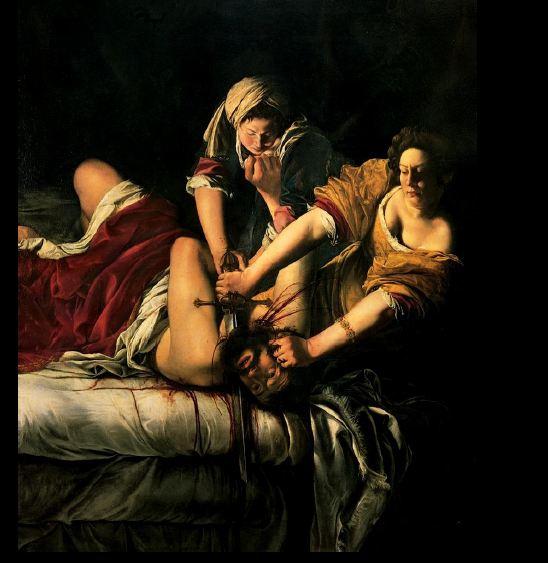
Judith Slaying Holhofernes 1613
Head Honchas
Orazio must have been a great influence on his daughter and she would have observed his working process at close hand. What becomes apparent is the difference in approach, when Artemisia paints she brilliantly reveals the complex layered psychology of a scene.
Caravaggio was another great influence and at times she rivals him but the great scope of his vision and the drama within his paintings is so all consuming that the comparison is hard to make. Caravaggio lived a short life, packed with painting and living it large as I’ve described in a previous blog post, but it is worth remembering that Artemisia maintained a long career as an artist -navigating all the perilous financial implications involved in this act- alongside giving birth to 5 children, three of whom survived infancy.
Head Hunter
Artemisia joined her father when he came to work for the Royal family in England where he carried out many commissions including the ceiling paintings at Queen’s House in Greenwich which were later transferred to Marlborough House. Whilst in London Artemisia painted her Self-Portrait as the Allegory of Painting 1639. In the painting she looks directly towards her subject, her prey. In one hand she holds a brush, sharp as an arrow, in another a palette, like a shield. She is primed, ready for action, hunting for meaning, defending truth.
Hang Down Your Head
On the pendant dangling from her neck is a hollow mask. We hide behind masks, thinking they will protect the thinly constructed illusions of ourselves that we hold on to. Death, oblivion, is masked by our little lives. Art is long and life is short, so goes the saying. The elders in the gallery know this. That’s why they are willing to risk traipsing across empty London streets during a pandemic on a cold winter’s day. They need to behold again the miracle of Art and worship once again at this temple of visions. We have come to this unholy communion to share the bodies and blood and to taste immortality for one brief moment.
A Severed Head
This mask symbol is a fitting symbol with which to end this exhibition. It’s a shrunken tokenistic severed head, hanging from the neck of a painter who took off her own mask and defied convention at every turn. She could never be gagged. Artemisia Gentileshi used her art to take revenge on male oppression, refusing to conform to the limited expectations of the male psyche.
Artemisia, the painter who turns heads and makes heads roll.
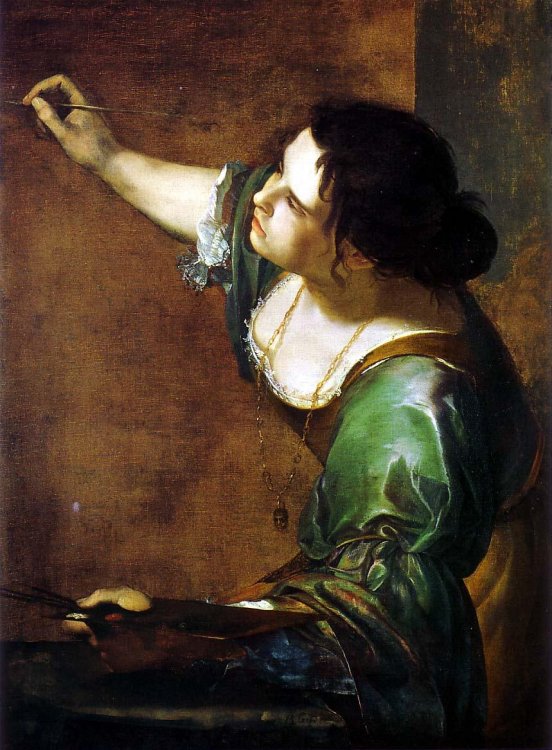
Self-Portrait as the Allegory of Painting 1639
Copyright EdGrayArt 2020